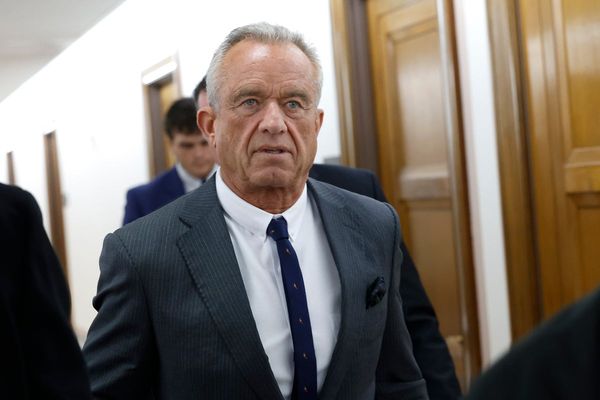
In early October 2001, then-U.S. Secretary of State Colin Powell sent a cable to his envoy in Pakistan, ordering her to get a message to the head of the Taliban through Pakistani middlemen: Stop harboring al Qaeda or else. The message, channeled through U.S. Ambassador to Pakistan Wendy Chamberlin to Taliban leader Mullah Mohammed Omar, came days before the U.S. invasion of Afghanistan, amid fears al Qaeda was planning more terrorist attacks on U.S. soil following Sept. 11.
“We will hold leaders of the Taliban personally responsible for any such actions. Every pillar of the Taliban regime will be destroyed,” the cable read.
Now, two decades later, the U.S. war in Afghanistan is coming to a close. And the Taliban, once threatened so bluntly by Washington with total annihilation, have never been stronger.
Taliban forces have taken control of an estimated 188 of Afghanistan’s 407 districts. They are close to seizing dozens of others. Some Afghan government forces have fled the country to escape Taliban advances, seeking refuge in neighboring Tajikistan and Uzbekistan. And amid the retreat, the militant group is seizing containers full of weapons and military hardware left behind by Afghan forces, in scenes some experts compare to Iraqi forces’ retreat from the Islamic State in 2014 that precipitated the rise of the Islamic State caliphate.
The specter of civil war—if not an outright Taliban takeover of the country and toppling of Kabul’s government—could be on the horizon, according to U.S. military commanders and reports on U.S. intelligence assessments.
Interviews with more than a dozen U.S. and Afghan officials as well as other regional experts show the policymaking community is still torn on whether the Taliban can take control of the entire country, including the heavily fortified capital of Kabul, or hold the provinces it has already captured. All agree that despite notes of optimism from U.S. President Joe Biden and his administration on Afghan peace talks, momentum is on the Taliban’s side.
But the Taliban faces their own challenges: how much blood to expend for the final push after two decades of unbroken combat, how to balance between moderates and hard-liners, and, most importantly, the future they envision for the country when the fighting stops.
As the battlefield shifts toward conventional fighting, the militant group could face fierce resistance in launching frontal assaults on major cities that it would need to fully retake the country, and some experts wonder how much the Afghan people—and possible Taliban recruits—will be willing to take.
“Fighting for the Taliban has been a family affair,” said Haroun Rahimi, a professor at the American University of Afghanistan. “One of the biggest questions they will have to deal with is what was all that death and killing for.”
But even without a political North Star beyond forcing the exit of U.S. troops, the group has shown remarkable resiliency, after two decades of costly counterinsurgency operations and nation-building projects by the United States and its NATO allies. It has bulked up its fighting force—which now stands at between 55,000 and 85,000 full-time fighters, according to estimates from experts—and worked to burnish its international credentials abroad as it attempts to portray itself as a serious diplomatic powerhouse in Afghanistan, all while preserving unity.
“The leadership seems pretty tight. They seem to have control over the commanders on the ground,” said Lisa Curtis, a former senior National Security Council official overseeing South Asia under the Trump administration. She pointed to the fact that when Taliban negotiators agreed to past cease-fires with the Afghan government, their commanders on the ground listened to them and halted fighting. “The Taliban are more unified. They have better command and control than we often give them credit for.”
“They’re an organization made up of human beings, so they’re not monolithic, and [they] never have been,” said Laurel Miller, the director of International Crisis Group’s Asia program and the former deputy special representative for Afghanistan and Pakistan. “That said, they have recognized that cohesion is a comparative advantage for them, and they have worked assiduously to maintain [it],” she said. “This is a moment where they have incentive to remain as cohesive as possible because they’re on a roll.”
But the fissures are visible already—and are only going to widen once the primary foe is out of the country.
“The critical thing about the Taliban is that they’ve not given much thought as to what system they actually want after a settlement or after what appears to be their strategy of military takeover,” said Ahmad Shuja Jamal, head of international affairs and regional cooperation on Afghanistan’s National Security Council. “And that is a problem because it can actually bring to the fore the cleavages that are in the Taliban [that] are very easy to see.”
The fractures break along regional and political lines. The group’s leadership is still defined by its roots in southern Afghanistan’s Kandahar province after the exit of the Soviet Union in the early 1990s. Leaders close to the Taliban’s late founder—including his son, Mullah Mohammed Yaqoob, and chief negotiator Mullah Abdul Ghani Baradar—still take precedence over factions like the Pakistan-based Haqqani network, which joined the movement later and has remained operationally distinctive.
One major bellwether of whether the group will stay united or fracture will be on the diplomatic front. Negotiations between the Afghan government and Taliban in Doha, Qatar, have effectively ground to a halt as the Taliban’s military arm makes sweeping gains in its military offensives, particularly across northern Afghanistan.
Most experts see this as part of a coherent strategy on the Taliban’s part: Drag their heels on peace talks while consolidating their territorial gains. “Even though you still have Taliban negotiators in Doha, they’re probably just seeking to bide time while the military makes its gains on the ground,” Curtis said, now at the Center for a New American Security, a think tank. “I think it’s probably a very well-coordinated strategy for the Taliban—talk, pretend like you’re interested in peace, but then keep fighting on the ground.”
In a press briefing on Tuesday, State Department spokesperson Ned Price did not directly address the rapid gains the Taliban made in recent weeks but doubled down on U.S. calls for peace talks. “We continue to urge all sides to engage in serious negotiations to determine a political road map that leads to … a just and durable political settlement,” he said. “The world will not accept an imposition by force of a government in Afghanistan.”
If their offensive slows or they are unable to topple the Afghan government, some experts believe more moderate factions of the Taliban will push for a peace deal while hard-line elements will advocate for continuing to fight.
“What is very striking is that the public messaging from the top [Taliban] leadership, and especially the political office in Doha, contrasts sharply with the messaging coming from the battlefield commanders,” said Michael Kugelman, an expert on South Asia at the Wilson Center, a think tank, and author of Foreign Policy’s South Asia Brief. Taliban military commanders have given interviews saying they are effectively ready to cast aside peace talks and conquer Afghanistan while negotiators tell foreign press outlets these offensives will strengthen their hand for future rounds of peace talks.
“The question is who’s going to win that argument? It’s hard to say at this point,” Kugelman said.
As the Taliban make gains on the ground in Afghanistan, they are also working to polish their international image and diplomatic hand as regional powers vie for influence in the country after the U.S. and NATO withdrawal. Their political branch has even put out statements on respecting human rights, although Western officials and other experts are skeptical.
“They put out nice English statements about respecting human rights and women’s rights, but we have yet to see it in action,” said Shaharzad Akbar, chairperson of the Afghanistan Independent Human Rights Commission.
“In addition to people getting harmed, killed, and injured in the conflict, the Taliban are cutting supply routes, cutting communication lines, and in some districts, they’re forcibly displacing populations,” Akbar said, who previously served as an advisor on Afghan President Ashraf Ghani’s National Security Council and helped broker Afghan-Taliban peace talks.
“The way the security situation is unfolding, unfortunately a human rights crisis is very likely unless there is attention and intervention,” she added.
Still, the Taliban are continuing their attempted version of a diplomatic charm offensive on the international stage. “My sense is that the Taliban see the international community as the biggest barrier. They don’t see other Afghans or Afghan factions, the Afghan Security Forces, as a barrier to their political ascendance,” said Asfandyar Mir, a South Asia security analyst at Stanford University.
But that charm offensive is undermined by the military one. “I think by forcing their hand on a strategy of violence and terrorism, they are now beginning to lose favor with the international community and also encountering organized resistance from all across the country against them by communities that have been pushed to the brink,” Jamal said.
Even so, neighboring countries and other regional powers like India are now talking to the Taliban—for a reason.
“The Chinese, the Russians, the Iranians, the central Asian states have all had formal talks with the Taliban in recent years,” Kugelman said. “India was really the last one. It is significant. India has read the writing on the wall as other countries in the region did, and India recognizes that no matter what happens post withdrawal, the Taliban will become even stronger than it already is.”
U.S. officials are working to counter the Taliban’s diplomatic offensive despite low internal confidence in the Ghani government in some corners of Washington. The Biden administration has also reached out to Russia, China, India, Turkey, Pakistan, and others about the Afghan peace settlement and has been setting up trilateral meetings between Kabul and its neighbors in Central Asia, the U.S. State Department told Congress in April. And Ghani’s top aides are trying to expand the government’s own diplomatic clout as a counterweight to the Taliban, with national security advisor Hamdullah Mohib traveling to Moscow for high-level meetings this week.
But some experts think the Taliban’s reception in foreign capitals is a sign that Afghanistan’s allies see them at the core of the country’s future, despite Ghani’s best efforts.
“The fact that you now have basically the entire region trying to engage with the Taliban suggests that everyone is aware of where the real power is going to lie in the months, years ahead,” Kugelman added. “It’s a sobering thought, the fact that everyone’s coming around feeling the need to engage with this murderous militant organization. It’s a sign of the times, unfortunately.”







